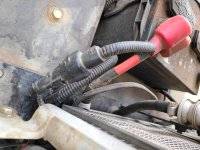The first step, always, is to check the voltage at the battery terminals while trying to start. If the voltage stays at 12v, then there is problem getting the power where it needs to be... if the voltage drops way down, then your battery has a problem [internal cell connection, bad cell, etc.]. Start at the battery, then move your ground connection to the frame somewhere, and then your + to the starter.
If you have good voltage all the way to the starter and your ground is good, you can try jumping the starter solenoid to ensure that the starter will turn over. Most tractors have a start safety switch somewhere in the starter circuit [clutch fully depressed, in neutral, seat, etc.], and limit switches that are intermittent or out of adjustment can easily inhibit the starting [which is why they were put there]. As with any electrical troubleshooting, you start with your known good voltages and find where it stops... and yes, that includes grounds and grounding circuits. Many times, there will be a main electrical connector that goes to the dash, and I've found that they sometimes have issues as moisture and dirt works their way into the connectors... try disconnecting and reconnecting a few times to clean off the connections [or use a plastic safe contact cleaner on them].

